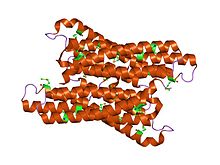- Cyclodeaminase domain
-
FTCD_C 
crystal structure of formiminotetrahydrofolate cyclodeaminase (tm1560) from thermotoga maritima at 2.80 a resolution Identifiers Symbol FTCD_C Pfam PF04961 InterPro IPR007044 SCOP 1o5h Available protein structures: Pfam structures PDB RCSB PDB; PDBe PDBsum structure summary In molecular biology, enzymes containing the cyclodeaminase domain function in channeling one-carbon units to the folate pool. In most cases, this domain acts as a formimidoyltetrahydrofolate cyclodeaminase, whichcatalyses the cyclisation of formimidoyltetrahydrofolate to methenyltetrahydrofolate as shown in reaction (1). In the methylotrophic bacterium Methylobacterium extorquens, however, it acts as a methenyltetrahydrofolate cyclohydrolase, which catalyses the interconversion of formyltetrahydrofolate and methylenetetrahydrofolate, as shown in reaction (2).[1]
(1) 5-formimidoyltetrahydrofolate = 5,10-methenyltetrahydrofolate + NH(3)
(2) 10- formyltetrahydrofolate = 5,10-methenyltetrahydrofolate + H(2)O
In prokaryotes, this domain mostly occurs on its own, while in eukaryotes it is fused to a glutamate formiminotransferase domain (which catalyses the previous step in the pathway) to form the bifunctional enzyme formiminotransferase cyclodeaminase.[2] The eukaryotic enzyme is a circular tetramer of homodimers, while the prokaryotic enzyme is a dimer.[1][3][4]
The crystal structure of the cyclodeaminase enzyme from Thermaotogoa maritima has been studied.[4] It is a homodimer, where each monomer is composed of six alpha helices arranged in an up and down helical bundle, forming a novel fold. The location of the active site is not known, but sequence alignments revealed two clusters of conserved residues located in a deep pocket within the dimmer interface. This pocket was large enough to accommodate the reaction product and it was postulated that this is the active site.
References
- ^ a b Pomper BK, Vorholt JA, Chistoserdova L, Lidstrom ME, Thauer RK (April 1999). "A methenyl tetrahydromethanopterin cyclohydrolase and a methenyl tetrahydrofolate cyclohydrolase in Methylobacterium extorquens AM1". Eur. J. Biochem. 261 (2): 475–80. doi:10.1046/j.1432-1327.1999.00291.x. PMID 10215859.
- ^ Murley LL, MacKenzie RE (August 1995). "The two monofunctional domains of octameric formiminotransferase-cyclodeaminase exist as dimers". Biochemistry 34 (33): 10358–64. doi:10.1021/bi00033a006. PMID 7654689.
- ^ MacKenzie RE, Aldridge M, Paquin J (October 1980). "The bifunctional enzyme formiminotransferase-cyclodeaminase is a tetramer of dimers". J. Biol. Chem. 255 (19): 9474–8. PMID 7410436.
- ^ a b Xu Q, Schwarzenbacher R, McMullan D, Abdubek P, Ambing E, Biorac T, Canaves JM, Chiu HJ, Dai X, Deacon AM, DiDonato M, Elsliger MA, Godzik A, Grittini C, Grzechnik SK, Hampton E, Hornsby M, Jaroszewski L, Klock HE, Koesema E, Kreusch A, Kuhn P, Lesley SA, Levin I, Miller MD, Morse A, Moy K, Ouyang J, Page R, Quijano K, Reyes R, Robb A, Sims E, Spraggon G, Stevens RC, van den Bedem H, Velasquez J, Vincent J, von Delft F, Wang X, West B, White A, Wolf G, Zagnitko O, Hodgson KO, Wooley J, Wilson IA (March 2005). "Crystal structure of a formiminotetrahydrofolate cyclodeaminase (TM1560) from Thermotoga maritima at 2.80 A resolution reveals a new fold". Proteins 58 (4): 976–81. doi:10.1002/prot.20364. PMID 15651027.
This article includes text from the public domain Pfam and InterPro IPR007044
Categories:- Protein families
Wikimedia Foundation. 2010.
